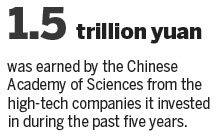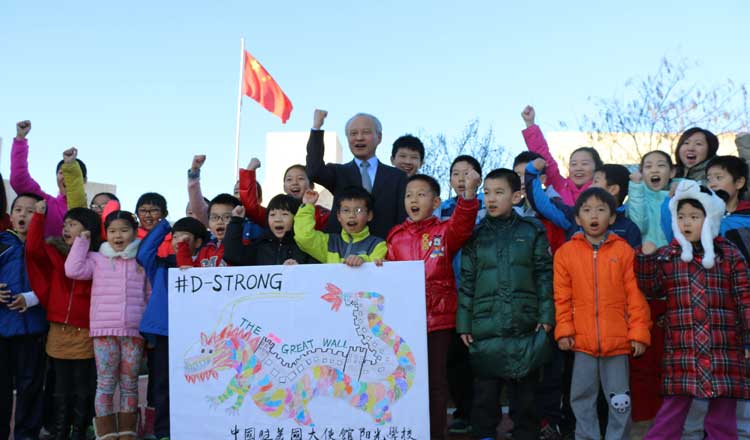Science academy powering research
Updated: 2016-01-18 16:27
By Cheng Yingqi(China Daily USA)
|
||||||||
Previous policy shift from focus on publications to originality and practicality paying benefits
The Chinese Academy of Sciences, China's national science academy, earned 1.5 trillion yuan ($227 billion) from the high-tech companies it invested in during the 12th Five Year Plan (2011-15).
The amount was equivalent to the annual GDP of Shenzhen in 2014 and contributed 220 billion yuan in taxes.
"The academy and its affiliated institutes transferred a great number of technologies developed in laboratories to commercial endeavors, and made significant contribution to the development of the social economy," said Yan Qing, director of the Bureau of Science and Technology for Development under the Chinese Academy of Sciences.
The transferred technologies include nano materials used in environmentally-friendly printing, quantum technology for security networks and new drugs to treat diseases such as cancer.
"During the 12th Five Year Plan (2011-15), we have been focusing on research directions to enhance industrial upgrading, to promote ecological protection and to improve people's well-being," Yan said at a news conference on Friday.
The academy reformed the evaluation system of its more than 100 affiliated research institutes in 2012, attaching less value to the number of academic papers published by individual researchers but more value to their originality and practical contribution.
During the last five years, 254 academy researchers with associate professorships or above quit their research jobs to start businesses.
Researchers in the academy could return to their original posts within three years if their businesses are not going well, according to a preferential policy.
In order to encourage technology transfers, the academy invested in a number of angel funds and incubators to smooth the establishment of high-tech startups.
"During the next five years, we hope to establish an intellectual property center and a special fund to further support technology transfers," Yan said.
As the country's economic growth has slowed in recent years, the Chinese government adopted new strategies recognizing the importance of scientific research in driving technological innovation and economic progress.

A development plan published by the State Council in 2006 set out a path to transform the country into a "science powerhouse" by 2020. Since then, great efforts have been poured into improving research capacity and boosting technology transfers at colleges and research institutes.
"China has the chance to be a research giant and establish a long-term culture of innovation," David Reiner, a senior lecturer in science and technology policy from Cambridge University's business school and a keen observer of China, was quoted by scientific magazine Nature in a supplement on China's research capacity published in December.
According to the Nature Index 2015 China supplement, China's contribution to high-quality science has become the second largest in the world, surpassed only by the United States.
"Clearly China is catching up to the US and is already a high-quality scientific powerhouse. The country's ever-increasing R&D budgets fueled by its burgeoning economy since the early 1980s have driven this pattern," said Nick Campbell, executive editor of Nature.
"The expansion in China's higher education system and improvements in the quality and quantity of its scientific workforce are key factors in delivering this impressive return on investment."
chengyingqi@chinadaily.com.cn
(China Daily USA 01/18/2016 page4)
- Tennessee couple first to claim Powerball jackpot
- Kerry to visit China in late January
- Getting to know the New Normal
- Massive dinosaur skeleton will spill out of hall at NY museum
- Pakistan confirms detention of top suspect of Indian airbase attack
- US sailors made 'navigational error' into Iranian waters

 The world in photos: Jan 11 - 17
The world in photos: Jan 11 - 17
 Commemorative coins for Year of Monkey issued across China
Commemorative coins for Year of Monkey issued across China
 Throw a flower ball to find Mr Right
Throw a flower ball to find Mr Right
 Retired hurdler Liu Xiang shows affection with new love
Retired hurdler Liu Xiang shows affection with new love
 Visitors enjoy free Laba porridge at Yonghe Lama Temple
Visitors enjoy free Laba porridge at Yonghe Lama Temple
 For police officers, duty is all in a day's work
For police officers, duty is all in a day's work
 Children at Chinese embassy in US send wishes to Dorian
Children at Chinese embassy in US send wishes to Dorian
 People prepare for Chinese New Year
People prepare for Chinese New Year
Most Viewed
Editor's Picks

|

|

|

|

|

|
Today's Top News
National Art Museum showing 400 puppets in new exhibition
Finest Chinese porcelains expected to fetch over $28 million
Monkey portraits by Chinese ink painting masters
Beijing's movie fans in for new experience
Obama to deliver final State of the Union speech
Shooting rampage at US social services agency leaves 14 dead
Chinese bargain hunters are changing the retail game
Chinese president arrives in Turkey for G20 summit
US Weekly

|

|